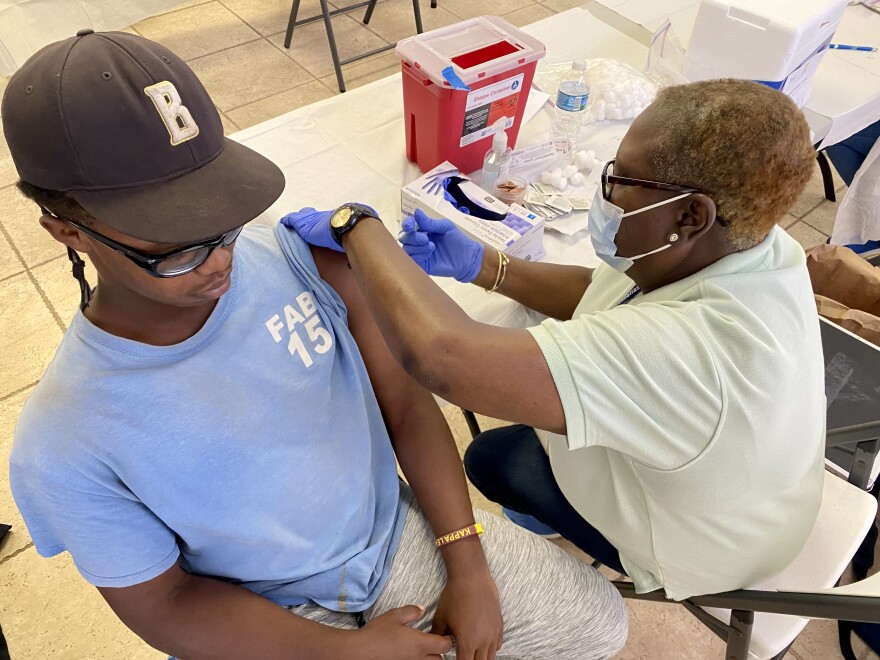Higher rates of COVID-19 infections and hospitalizations are disproportionately affecting children of color and creating racial disparities when it comes to vaccinations, a Sept. 16 analysis by the Kaiser Family Foundation found.
The research’s findings outlined how COVID-19 has disproportionately affected Black, Hispanic, Asian, American Indian and Alaska Natives (AIAN) as well as Native Hawaiians and other Pacific Islander children 19 and younger compared to white children.
Children of color showed to have lower rates of testing, but when it came to infection, they were more likely to test positive for COVID-19.
“From available data, there are some disparities in how children of color are experiencing a pandemic compared to white children, and some of those disparities are seen in the rates of hospitalization, the severity of COVID-19,” said Nambi Ndugga, a policy analyst with the foundation.
“Children of color are being more affected in school than their white counterparts, so they are experiencing a higher rate of learning loss during this time period.”
Out of the 4.9 million infections, over 39,000 hospitalizations and 725 deaths recorded due to COVID-19 nationwide, AIAN and Black children as of Aug. 31 were 3.5 and 2.7 times more likely to die from the virus than white children, respectively, according to the study.
The risks of exposure were higher among these groups, Ndugga said, as they tend to live in more densely populated areas, have larger household sizes, and live in larger households with members in essential jobs unable to work remotely.
The study also found that a high number of children of color who were uninsured experienced higher rates of hospitalizations and more severe forms of COVID-19. Higher rates of infection were recorded for AIAN, Native Hawaiian and other Pacific Islander children, and Hispanic children.
Hospitalization trends were also higher for AIAN, Black and Hispanic children, who are more likely to have multisystem inflammatory syndrome (MIS-C). They were two to three times as likely to be hospitalized as a result of COVID-19 than other groups.
The impacts are not limited to their health and wellbeing, however. The study showed that the pandemic has also affected children’s academic growth in schools.
Black and Hispanic students, for instance, experienced learning loss and fell behind academically due to the lack of access to remote learning and high-speed internet, according to the study.
Such findings, Ndugga said, could further expand existing gaps in academic performance as well as in health and wellbeing between children of color and white children.
“What we have seen is that children of color are more likely to experience learning loss,” she said. “And this again is related to these underlying structural inequities that they faced prior to the pandemic and are being exacerbated during the pandemic, and these include like access to high-quality internet, which may impact virtual learning.”
“Some of the things that we do see being successful is increasing the availability of data to understand vaccine rates among children by race and ethnicity, which will help us identify and assess disparities, and help us direct resources and efforts to address them.”
“As we see vaccination eligibility expand to more children, we’re building on lessons learned from providing vaccines to other populations to help reduce access barriers and address people's questions and concerns surrounding the vaccine, and making use of pediatricians and other trusted members in the community to disseminate vaccinations among these groups.”
The U.S. Food and Drug Administration on May 10 approved the emergency use authorization of the Pfizer-BioNTech COVID-19 vaccine for adolescents 12-15 years old. Currently, the FDA is currently reviewing findings from vaccine trials in children between 5 and 11 years old to determine if it’s safe.
The manufacturer released a statement Monday showing positive results in the vaccine’s efficacy in younger children. The estimate, according to CNN, is to start vaccinating children 5 and older by the end of October.
Ndugga said ensuring an equitable distribution of the COVID-19 among children is essential to overcoming racial disparities.
Accessing data for the research, however, has been challenging, according to Ndugga. She said racial ethnicity data has been more “sparse” compared to other forms, which makes it more challenging to find ways to address racial disparities during the pandemic.
“A lack of data makes it a little bit more difficult for people to create adequate responses -- adequate strategies to providing vaccinations -- in a way that is accessible and culturally sensitive to the populations they want to serve,” Ndugga said.
“A lot of what we are seeing now may have a lot of downstream effects that we aren't aware of quite yet. So mitigating those disparities, at this time, will help us prevent that.”
As more data becomes available, Ndugga said the foundation will start researching the long-term impacts of the virus.
“We will definitely be assessing it to determine how the trends are going. Whether we are seeing improvements in disparities among racial and ethnic groups, or if we are going the other direction,” Ndugga said.
“More studies like this could have much larger impacts not just in the pandemic but in healthcare as a whole, and will help us figure out ways to address disparities in health care access and public communications, and other aspects of public health that will benefit racial and ethnic minorities as a whole.”
Copyright 2021 WUSF Public Media - WUSF 89.7. To see more, visit WUSF Public Media - WUSF 89.7. 9(MDAyNDY5MjM1MDEyODE2MzMyMTZmZDQwMg001))




